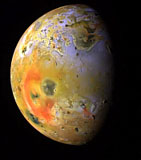





Io is the closest to Jupiter of its large
moons. It orbits just outside Jupiter's ring system and undergoes
extreme geological distortions, due to tidal interactions between Jupiter
and the other three large moons. This distortion - as much as 100
meter (330 feet) rise and fall in the land surface - generates internal
frictional heat. This in turn causes the rocky interior of Io to
melt and expand. The surface of Io is exposed to the cold of space
and most of it is therefore cool and solid. The molten interior
breaks through the surface in places creating highly active volcanoes,
which constantly remodel the surface through lava flow and ash dumping.
Some parts of Io's surface are maintained at temperatures favorable for
life and protected below the surface from radiation, by the fluffy outfall
from the volcanoes, primitive life may be able survive. However,
it is unlikely that any water remains on Io and this is essential for
life to prosper. It is therefore unlikely that life could have started
on Io, but conditions may be right for life that has been brought to Io
on space debris. Survival in stasis or at a very slow rate of metabolism
may be possible,.
Galileo
Takes a Closer Look at Io
Io Fly-by animation
© All images NASA
Go
to
Home
| Space Station
| Mars | Rainforest
© 1999 Satellite Events Enterprises Inc.